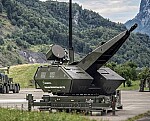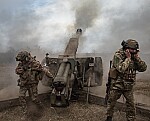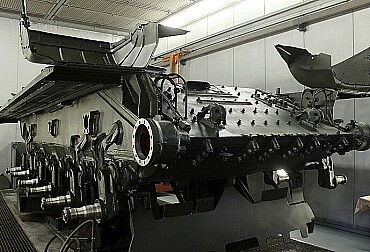NATO Continues to Strengthen Its Capabilities: Turning the Hague Summit into Concrete Action
The defense ministers of the North Atlantic Treaty Organization recently met at their Brussels headquarters for their first meeting since the June summit in The Hague. While in June the member states agreed on an unprecedented increase in defense spending to five percent of gross domestic product by 2035, the October meeting showed how to put these commitments into practice. The main topics were anti-drone technology, the expansion of Operation Eastern Sentry, and continued support for Ukraine.

The October meeting of NATO defense ministers took place against a security backdrop that had been significantly influenced by the events of previous months. The summit in The Hague in June 2025 brought a historic decision to invest five percent of gross domestic product in defense by 2035—the largest increase in European defense budgets since the end of the Cold War. Of this amount, three and a half percent will go to direct military spending, with the remaining one and a half percent going to security and defense investments, including infrastructure and industrial capacity.
There are clear reasons for this decision. Russian aggression against Ukraine continues and is destabilizing the Euro-Atlantic area. Since spring 2022, NATO member states have provided Kiev with the bulk of foreign military aid. At the same time, incidents on the Alliance's eastern border are on the rise. In September, Russian drones violated Polish airspace during an attack on Ukrainian targets near the common border. Similar violations of airspace sovereignty have previously been reported by Romania, Estonia, Latvia, and Lithuania. These repeated incidents have created a series of security challenges to which the Alliance has had to respond.
NATO's response was swift. On September 12, just two days after the incident in Poland, Operation Eastern Sentry was announced. It follows on from the earlier Operation Baltic Sentry, which focused on protecting critical infrastructure in the Baltic Sea. Eastern Sentry was conceived as a flexible military activity designed to strengthen the defense of the entire eastern flank of the Alliance, from the Nordic countries to the Black Sea and the Mediterranean. General Alexus Grynkewich, Supreme Allied Commander Europe, emphasized that the operation combines traditional military means with new technologies aimed at defending against unmanned aerial vehicles.
The Alliance is ready to ensure the security of the billion inhabitants of its member countries
The meeting of defense ministers yielded results in several areas. NATO Secretary General Mark Rutte emphasized that the Alliance remains a defensive organization ready to ensure the security of one billion people in member countries.
The first topic was strengthening protection against drones as part of Operation Eastern Sentry. Key member countries, including Denmark, France, the United Kingdom, and Germany, are involved in this operation. Ministers approved the testing of integrated systems directly in the field and deepened cooperation with the European Union and the private sector. The Secretary General praised the international solidarity shown by allied countries in providing Denmark with technical equipment after incidents in which drones disrupted operations at Copenhagen Airport and appeared near military bases.
The second topic was the implementation of defense investments agreed upon in The Hague. Discussions focused on new capability goals requiring a substantial strengthening of capacities. The expansion of air and missile defense systems is key. Currently, the US Patriot system, designed for long-range ballistic missiles, the German IRIS-T, optimized for rapid response at medium ranges, and the Italian-French SAMP-T are in use. IRIS-T is becoming the preferred system of many European countries due to its effectiveness against drones and maneuverable missiles, while demand for the Patriot system exceeds production capacity.
Ahead of the summit in The Hague, NATO Secretary General Mark Rutte emphasized the need for a substantial strengthening of air and missile defense. Alliance commanders have repeatedly pointed out that new technologies need to be deployed quickly and that cost-effective sensors and effectors are needed to defend against mass attacks by unmanned aerial vehicles.
The third pillar was continued support for Ukraine. In the afternoon, the NATO-Ukraine Council met with the participation of Ukrainian Defense Minister Denys Shmyhal and European Union High Representative Kaja Kallas. This was followed by a meeting of the Ukraine Defense Contact Group, currently led by the United Kingdom and Germany. Rutte also emphasized that while Russia continues to attack civilian infrastructure ahead of winter, support for Ukraine remains continuous. Part of this support is the Ukraine Priority Requirements List initiative, under which several countries, including Canada, Denmark, Germany, the Netherlands, Norway, and Sweden, are financially supporting the delivery of American weapons systems to Kyiv.
A fundamental shift in NATO's approach to security
The October meeting of defense ministers reveals a fundamental shift in NATO's approach to security. The Alliance is moving from reactive crisis response to systematic resilience building and preventive capabilities. This shift is reflected in the speed with which Operation Eastern Sentry was launched and in the focus on technological innovation in the field of defense against unmanned aerial vehicles. The Alliance is no longer just a military alliance with a collective defense mechanism under Article 5, but is transforming into a comprehensive security architecture linking military, technological, and diplomatic instruments.
The key issue remains European autonomy within the transatlantic partnership. The decision on the five percent target for defense spending means that European countries will have to significantly strengthen their own military capabilities, which creates the conditions for greater strategic independence. This dynamic is linked to US policy demanding that European allies bear a greater share of the responsibility for collective defense. From the US perspective, the Hague summit was a success thanks to the agreement on an ambitious increase in spending. For Europe, however, this agreement represents not only an opportunity but also a commitment to build its own defense capabilities.
The target of five percent of gross domestic product means that many European countries will have to shift significant resources from other areas of public finance, which may affect social programs, healthcare, and education. Political feasibility will depend on the ability of governments to convince the public of the urgency of security threats. Some member states have already announced ambitious plans to increase their defense budgets, while others are still looking for ways to meet the new targets.
Conclusion
The Brussels meeting demonstrated that the Alliance is undergoing a significant stage in its evolution. The ability to translate the strategic commitments made in June into concrete operational steps within four months demonstrates the vitality of an organization approaching its 80th anniversary. The rapid announcement of Operation Eastern Sentry after the incident in Poland, the coordination of support for Ukraine among dozens of countries, and the mobilization of significant financial resources for defense modernization show that the Alliance has retained its capacity to adapt to a changing security environment.
Future developments will depend on three dimensions. The first is the technological race in the field of drones and defense systems, where the pace of innovation itself is a security factor. NATO must create mechanisms to enable a faster transition from research to operational deployment through closer integration of the private sector and scientific institutions. The second dimension is the financial-political area. The target of five percent of gross domestic product requires not only political will, but also macroeconomic coordination to ensure the sustainability of these investments. The third dimension is transatlantic balance. European states are gaining greater capabilities and thus potentially greater influence in defining the strategic direction of the Alliance, which requires a sensitive diplomatic approach.
The Alliance's strategic thinking has shifted from the concept of deterrence to the doctrine of resilience, i.e., the ability to withstand a variety of threats ranging from military attacks to cyberattacks and disinformation campaigns. This approach requires investment not only in traditional military assets, but also in cybersecurity, energy independence, and critical infrastructure protection. The Alliance is learning from the conflict in Ukraine, where it has become clear that modern warfare requires extensive ammunition supplies, rapid replenishment of losses, and a resilient logistics network capable of functioning even under enemy pressure.









